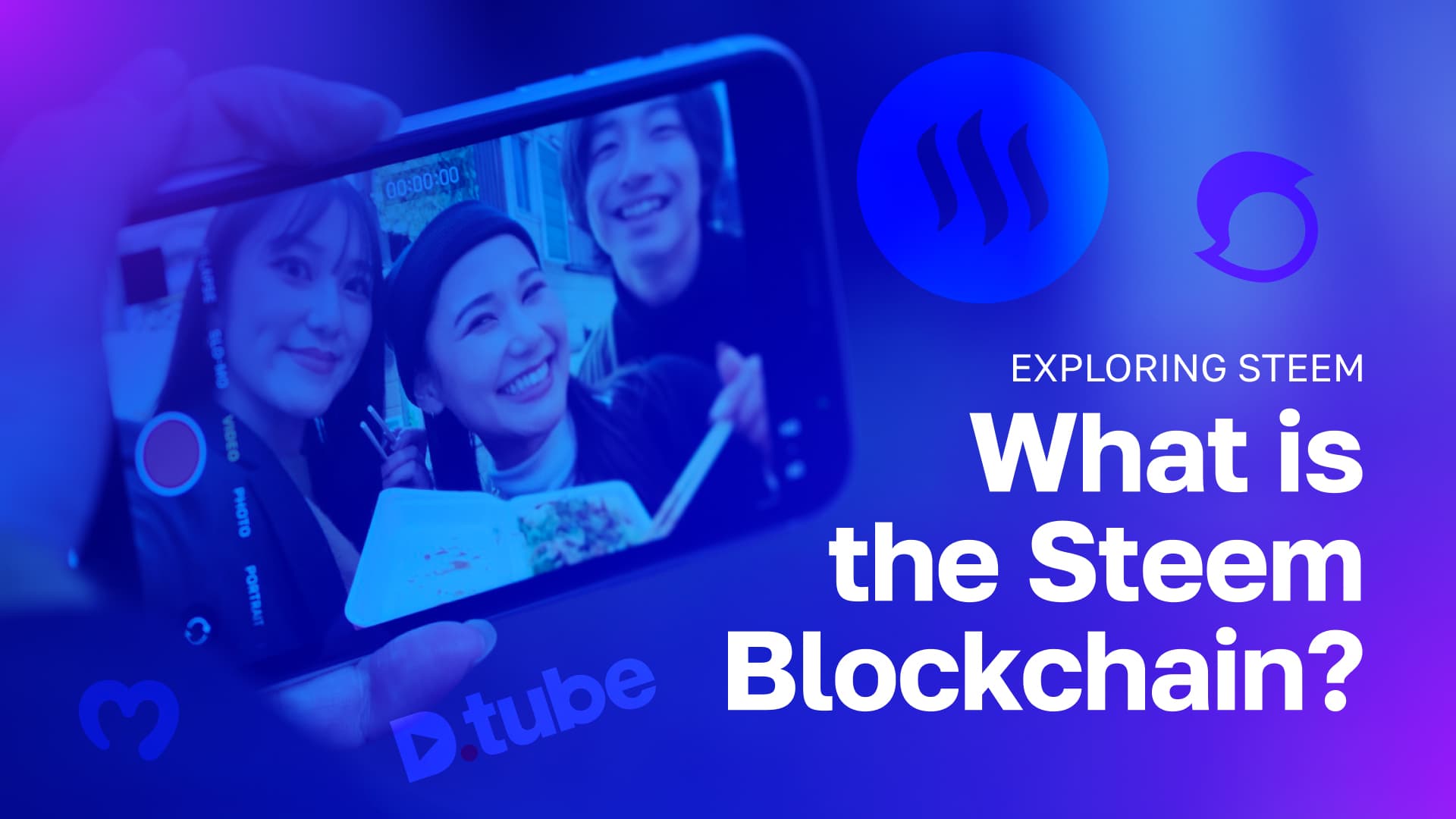One of the first things to come to mind for many when talking about cryptocurrency is Bitcoin (BTC), but the crypto market is broad and varied, extending far beyond digital payments. The Steem blockchain is a clear example of crypto innovations beyond digital payments. Today, there are crypto projects that provide users with meaningful innovations in various fields. DeFi protocols, NFTs, and blockchain games are all essential parts of the crypto ecosystem. However, community building is one of the areas of the blockchain industry that still doesn’t have many active projects. The Steem network is a blockchain project focusing on building communities. Web2 social media platforms allow users to create content, but don’t let them own it. They can censor content, ban users, make new rules, and even shut down the platform. Steem brings users an alternative to these centralized social experiences.
In this article, we’ll look at the Steem blockchain to find out what it is, its key features, and how it works. Also, we’ll find explore the blockchain’s three crypto tokens and the broader Steem ecosystem.

The crypto world boasts an abundance of innovations in various fields, from decentralized finance to NFTs and blockchain gaming. Start your crypto journey with the Crypto for Beginners course at Moralis Academy.
The Steem Network
The Steem blockchain focuses on community building by providing developers with a framework for launching decentralized social platforms. Traditional social media platforms are privately-controlled and don’t give users ownership over their content. Steem uses a blockchain infrastructure that incentivizes users to produce content and interact with each other. Steemit is the first and most popular social app on Steem. However, various additional apps use the Steem network to power their communities and reward users for their activity.
Steem is a combination of a social media framework and blockchain technology. The apps that use the Steem blockchain reward their users for their original contributions to the community. Writing comments, sharing content, liking posts, and interacting with other users are some of the activities Steem rewards. The Steem developer team aims to give social media users a part of the value they create when using a social network. Blockchain technology is ideal for this concept because it allows users to receive crypto rewards in their wallet apps quickly.
Steem’s network architecture also allows users to participate in the governance of social platforms by holding STEEM tokens. The whole idea of the network is to create social media platforms built and run by the community.

Blockchain technology and Bitcoin are vital pillars of the crypto market. Learn the essentials with the Blockchain and Bitcoin 101 course at Moralis Academy.
Steem Blockchain Performance
Every interaction on a Steem-based platform is a form of blockchain transaction. Steem social media platforms like Steemit have far fewer users than Facebook, but they are technically capable of mass expansion. Because of this, Steem needs to be able to process a massive number of transactions simultaneously. The Steem blockchain can process 1,000 transactions per second, with the potential to scale up to 10,000 transactions per second when necessary. Steem uses a blockchain solution based on the highly scalable Graphene network. Transactions on Steem take three seconds on average, so interactions with Steem apps are pretty fast. Also, the Steem blockchain is decentralized and uses numerous network nodes to validate transactions.
Traditional social media platforms use centralized networks instead of blockchains. These networks often malfunction, and sometimes the whole platform temporarily shuts down. For example, Facebook has had numerous short-term outages since its launch. Additionally, centralized platforms hold a lot of sensitive data and personal user information. Platforms on the Steem network don’t gather personal information, and they are decentralized.

Check the blockchain guides section at Moralis Academy to learn more about the essential aspects of blockchain technology. Also, save our crypto terminology guide to understand the critical terms of the crypto market.
Benefits of the Steem Blockchain
The Steem blockchain carries various benefits for developers, entrepreneurs, and social media users.
Steem is quite unique among blockchain projects because it focuses on community building and providing users with incentives for activity. The network provides developers with a practical framework for launching different social apps and projects. These projects can have various forms. Someone might create a classic social media platform similar to existing Web2 platforms but based on blockchain technology. Another developer can create a video streaming platform that incentivizes users to post their videos and rate other users. Other developers can start a micro-niche social app focused on anything from clothing, music, and games to movies and art. The Steem blockchain is like a playground for developers because they can create any type of social platform.
Entrepreneurs can utilize Steem’s architecture to launch their projects and monetize the content they create. Active content creators also get rewards on Steem platforms, just like curators. For example, if you’re an active blogger or video creator and the community likes your projects, Steem will automatically reward you. Monetization is much more challenging on Web2 platforms like YouTube, where users need to reach a massive audience to earn money. Steem incentivizes entrepreneurs from day one to create content and promote their projects.
Social media users are the driving force behind the Steem network. Steem-based apps reward users for participating in the community, submitting comments, liking, and sharing content. Active users who contribute the most to the community get even more rewards. This mechanism incentivizes users to stay active and contribute to Steem’s social platforms.

The Steem Network Consensus Mechanism
Steem uses a unique blockchain consensus mechanism called Delegated Proof-of-Stake (DPoS). This mechanism utilizes decentralized network nodes to validate transactions with the help of staked crypto. Steem validator nodes are called witnesses and get 10% of block rewards from each new blockchain data block. The network sends 75% of the STEEM tokens from block rewards to the network’s reward pool. Users across all Steem network apps get rewards from this pool, no matter if they are content creators or curators. The rest of the tokens go to Steem Power (SP) holders.
The Steem blockchain produces new data blocks in rounds. Each round has 21 witnesses who sign new data blocks, and the network shuffles them for each round. The shuffling is necessary to ensure none of the witnesses take advantage of their position and manipulate transfers.

Ethereum is the second-largest crypto on the market and the largest ecosystem for launching decentralized apps. Learn all the essentials with the Ethereum 101 course at Moralis Academy.
Steem Fee Mechanism
Using a social media platform is usually free, and users are often accustomed to liking, sharing, and commenting without fees. However, blockchain transactions require transaction fees, and every interaction on Steem apps is a transaction. Steem developers know that fees for basic operations like submitting posts or commenting would be very unpopular among users. Fees would dramatically raise the entry barrier for Steem platforms because only users who can afford the fees would use the platforms. Even micro fees with values less than 0.01 USD would pressure users because all of those micro fees add up. Users can’t predict how much money they will spend on social media during the day, so the fees could be a deterrent.
The Steem team believes everyone should have access to social media platforms regardless of economic status. Because of this, there are no transaction fees on the Steem network. The Steem blockchain constantly processes transactions that result from user interactions with Steem platforms. Instead of charging users for their interactions, Steem has a bandwidth-limiting protocol. Users get a specific weekly bandwidth to ensure no malware or bot is misusing the bandwidth. However, users with more Steem Power tokens get more bandwidth.
Starbucks recently joined the Web3 scene with its NFT loyalty program. Learn more about the Starbucks Odyssey NFT program at Moralis Academy.
Steem (STEEM)
Steem (STEEM) tokens are the primary cryptocurrency of the Steem network. The other Steem cryptocurrencies, Steem Power (SP) and Steem Dollars (SBD), are closely tied to STEEM tokens. STEEM is the blockchain’s primary exposure to the broader crypto market, and users can trade STEEM on numerous crypto exchanges. Also, Steem witnesses get rewards in STEEM tokens.
According to available data, STEEM has a circulating supply of over 422 million tokens. There’s no specified maximum amount of STEEM tokens. The network constantly produces new STEEM tokens by validating transactions and adding new blocks to the blockchain.
Steem Power (SP)
Steem Power (SP) tokens encourage users to invest long-term in the Steem ecosystem. Many crypto users invest in specific cryptocurrencies to quickly earn some profits. However, many savvy investors are attracted to long-term growth potential. Steem Power rewards long-term investors.
Steem network users can lock their STEEM tokens with a 13-week vesting mechanism. These STEEM tokens become SP tokens, and you can’t trade them on crypto exchange platforms. The only way to get your SP tokens back on the market is by exchanging them back to STEEM on the blockchain. Users gain influence on Steem platforms according to the number of SP tokens they hold. When users vote or endorse certain content, they have more influence on the distribution of STEEM rewards if they have more SP tokens. Through this mechanism, the Steem network encourages users to vest their STEEM tokens and keep them in the form of SP. Users can grow their influence by depositing more SP, which results in higher reward rates for interacting on Steem platforms.
Additionally, SP holders get a share of the 15% of annual inflation from new STEEM tokens in proportion to the total amount of their SP tokens. Users who exchange STEEM to SP power up their participation in the Steem blockchain. Likewise, when converting SP back to STEEM, users are powering down their network participation.
Steem Dollars (SBD)
Steem Dollars (SBD), also known as Steem Blockchain Dollars, are the Steem network’s attempt at creating a stablecoin. Since cryptocurrencies are generally volatile assets, a Steem stablecoin would be very useful for helping users combat volatility. Originally, SBD was designed to maintain a value as close as possible to the US dollar. However, SBD de-pegged soon after its launch. Unlike most stablecoins that fail to maintain their peg and drop down in value, SBD increased in value dramatically. Currently, the value of SBD is over 2 USD per token. Moreover, Steem Dollars proved to be just as volatile as most other cryptocurrencies.

The Solana blockchain is one of the leading networks for NFTs. Check our guide on the top Solana NFT marketplaces to learn more.
Steemit – The Key Product of the Steemit Blockchain
Steemit is the first and most prominent app on the Steem blockchain. According to the project’s website, there are more than 320 apps on Steem, but Steemit is by far the most popular one. Steemit launched operations in 2016 as a community-driven decentralized social media platform. Users get rewards for posting content, liking, and interacting with other users. The platform is most popular for blogging and discussions between users. Popular comments and posts are rewarded with an increased amount of STEEM tokens. Steemit is available worldwide, and it supports various languages. For instance, a considerable portion of posts on Steemit are in Korean. The platform incentivizes users to interact with each other and publish quality content.
Unlike centralized social media, Steemit doesn’t require users to provide sensitive information. Additionally, the platform advocates free speech and encourages users to express themselves freely. The community regulates the content because users get to support and boost the content they find pleasing.
Exploring Steem – What Is the Steem Blockchain? – Summary
The Steem blockchain is different from most blockchain projects. Steem focuses on building decentralized social media platforms and online communities. The network rewards curators and creators for contributing to the community through comments, content, and interactions. Users get crypto rewards for helping the community grow and creating top-quality content.
Steem-based apps are still far from mainstream adoption and can’t compete with Facebook and Instagram. However, the Steem operational mechanism is very community-centric, and could provide an equitable alternative to Web2 social platforms.

Learn how to build a Web3 dapp with Moralis today.




